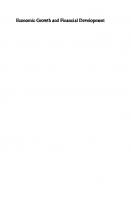Dynamic Macroeconomic Models in Emerging Market Economies: DSGE Modelling with Financial and Housing Sectors 9789811545870
This book summarizes the evolution of modern macroeconomics (New Consensus Macroeconomics, NCM) and proposes a new appro
338 103 7MB
English Pages 312 [296] Year 2020
Table of contents :
Foreword
Preface
Acknowledgements
Contents
Acronyms
List of Figures
List of Tables
Part I Introduction
1 Introduction to Modern Macroeconomic Models
1.1 Old Time Economics
1.2 The New Consensus Macroeconomics
1.3 Dynamic Stochastic General Equilibrium Models
References
2 Time to Improve the Existing Models
2.1 Criticism on Existing DSGE Models
2.2 New Dynamic Macroeconomic Models for Emerging Market Economies
2.2.1 Financial Sector
2.2.2 Real Estate Market
2.2.3 Social Structure and Household Stratification
2.2.4 Why Emerging Market Economies and Why Brazil, India and China
References
Part II Dynamic Macroeconomic Modelling
3 Traditional Dynamic Macroeconomic Models
3.1 It All Starts from Solow
3.2 The Stochastic Models
3.3 Money and Finance in RBC/DSGE Models
3.3.1 Money in the Utility
3.3.2 Cash in Advance
References
4 Modern Mainstream Macroeconomic Models
4.1 Manufacturer Firms
4.1.1 Intermediate Manufacturer
4.1.2 Final Goods Producer
4.1.3 Price Rigidity
4.2 Household Sector
4.2.1 Labour Market
4.3 The General Equilibrium
References
Part III The Financial and Housing Sectors Asymmetric Model for Emerging Market Economies
5 Overview and General Assumptions
5.1 The Incentives to Build New Dynamic Macroeconomic Models for Emerging Market Economies
5.2 General Assumptions
References
6 The Basic Model
6.1 Theoretical Framework
6.1.1 Household Sector
6.1.2 Production Sector
6.1.3 The Steady State
6.2 Theoretical Summary and Testable Hypotheses
References
7 The Advanced Model
7.1 Theoretical Framework
7.1.1 Household Sector
7.1.2 Production and Technology
7.1.3 Nominal Rigidity
7.1.4 Monetary Policy
7.1.5 General Equilibrium
7.1.6 Unexpected Shocks
7.2 Theoretical Summary and Testable Hypotheses
References
8 The Full Model
8.1 Theoretical Framework
8.1.1 Household Sector
8.1.2 Production and Nominal Rigidities
8.1.3 Financial Market and the Optimal Debt Contract
8.1.4 General Equilibrium
8.1.5 First Order Conditions
8.1.6 Shocks
8.1.7 Steady State
8.2 Theoretical Summary and Testable Hypotheses
References
9 Solving DSGE Models
9.1 Linearizing the Non-Linear Dynamic Stochastic Models
9.2 The State-Space Representation of the DSGE Model
9.3 Blanchard 數瑥湤慳栠Kahn Condition
References
Part IV Empirical Analysis
10 Empirical Methodologies and Software Tools
10.1 Empirical Methodologies
10.1.1 Calibration
10.1.2 Bayesian Estimation with Markov Chain Monte Carlo Methods and the Metropolis 數瑥湤慳栠Hastings Algorithm
10.2 Software Tools
References
11 Data, Statistics and Stylized Facts
11.1 Data
11.2 Stylized Facts
References
12 Empirical Analysis
12.1 Empirical Analysis of the Basic Model
12.1.1 The Empirical Results
12.1.2 The Impulse Responses
12.1.3 Social Stratification
12.2 Empirical Analysis of the Advanced Model
12.2.1 Parameter Identification
12.2.2 Empirical Study of the Model Economy
12.2.3 The Impulse Response
12.3 Empirical Analysis of the Full Model
12.3.1 Parameter Identification
12.3.2 Empirical Study of the Model Economy
12.3.3 The Impulse Responses
References
Part V Summary
13 Conclusion and Discussion
13.1 Conclusion
13.2 The Potentials of FHSAM
Glossary
Foreword
Preface
Acknowledgements
Contents
Acronyms
List of Figures
List of Tables
Part I Introduction
1 Introduction to Modern Macroeconomic Models
1.1 Old Time Economics
1.2 The New Consensus Macroeconomics
1.3 Dynamic Stochastic General Equilibrium Models
References
2 Time to Improve the Existing Models
2.1 Criticism on Existing DSGE Models
2.2 New Dynamic Macroeconomic Models for Emerging Market Economies
2.2.1 Financial Sector
2.2.2 Real Estate Market
2.2.3 Social Structure and Household Stratification
2.2.4 Why Emerging Market Economies and Why Brazil, India and China
References
Part II Dynamic Macroeconomic Modelling
3 Traditional Dynamic Macroeconomic Models
3.1 It All Starts from Solow
3.2 The Stochastic Models
3.3 Money and Finance in RBC/DSGE Models
3.3.1 Money in the Utility
3.3.2 Cash in Advance
References
4 Modern Mainstream Macroeconomic Models
4.1 Manufacturer Firms
4.1.1 Intermediate Manufacturer
4.1.2 Final Goods Producer
4.1.3 Price Rigidity
4.2 Household Sector
4.2.1 Labour Market
4.3 The General Equilibrium
References
Part III The Financial and Housing Sectors Asymmetric Model for Emerging Market Economies
5 Overview and General Assumptions
5.1 The Incentives to Build New Dynamic Macroeconomic Models for Emerging Market Economies
5.2 General Assumptions
References
6 The Basic Model
6.1 Theoretical Framework
6.1.1 Household Sector
6.1.2 Production Sector
6.1.3 The Steady State
6.2 Theoretical Summary and Testable Hypotheses
References
7 The Advanced Model
7.1 Theoretical Framework
7.1.1 Household Sector
7.1.2 Production and Technology
7.1.3 Nominal Rigidity
7.1.4 Monetary Policy
7.1.5 General Equilibrium
7.1.6 Unexpected Shocks
7.2 Theoretical Summary and Testable Hypotheses
References
8 The Full Model
8.1 Theoretical Framework
8.1.1 Household Sector
8.1.2 Production and Nominal Rigidities
8.1.3 Financial Market and the Optimal Debt Contract
8.1.4 General Equilibrium
8.1.5 First Order Conditions
8.1.6 Shocks
8.1.7 Steady State
8.2 Theoretical Summary and Testable Hypotheses
References
9 Solving DSGE Models
9.1 Linearizing the Non-Linear Dynamic Stochastic Models
9.2 The State-Space Representation of the DSGE Model
9.3 Blanchard 數瑥湤慳栠Kahn Condition
References
Part IV Empirical Analysis
10 Empirical Methodologies and Software Tools
10.1 Empirical Methodologies
10.1.1 Calibration
10.1.2 Bayesian Estimation with Markov Chain Monte Carlo Methods and the Metropolis 數瑥湤慳栠Hastings Algorithm
10.2 Software Tools
References
11 Data, Statistics and Stylized Facts
11.1 Data
11.2 Stylized Facts
References
12 Empirical Analysis
12.1 Empirical Analysis of the Basic Model
12.1.1 The Empirical Results
12.1.2 The Impulse Responses
12.1.3 Social Stratification
12.2 Empirical Analysis of the Advanced Model
12.2.1 Parameter Identification
12.2.2 Empirical Study of the Model Economy
12.2.3 The Impulse Response
12.3 Empirical Analysis of the Full Model
12.3.1 Parameter Identification
12.3.2 Empirical Study of the Model Economy
12.3.3 The Impulse Responses
References
Part V Summary
13 Conclusion and Discussion
13.1 Conclusion
13.2 The Potentials of FHSAM
Glossary

![Dynamic Macroeconomic Models in Emerging Market Economies: DSGE Modelling with Financial and Housing Sectors [1st ed.]
9789811545870, 9789811545887](https://ebin.pub/img/200x200/dynamic-macroeconomic-models-in-emerging-market-economies-dsge-modelling-with-financial-and-housing-sectors-1st-ed-9789811545870-9789811545887.jpg)

![The Stock Market: Crisis, Recovery and Emerging Economies : Crisis, Recovery and Emerging Economies [1 ed.]
9781612090450, 9781611225457](https://ebin.pub/img/200x200/the-stock-market-crisis-recovery-and-emerging-economies-crisis-recovery-and-emerging-economies-1nbsped-9781612090450-9781611225457.jpg)






